Newsletter

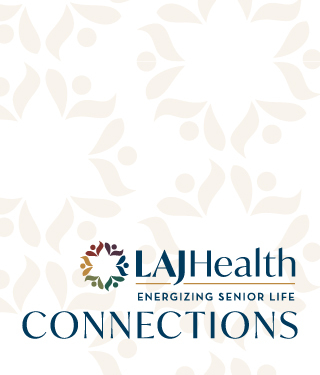
Our Newsletter
Connections
Dec
4
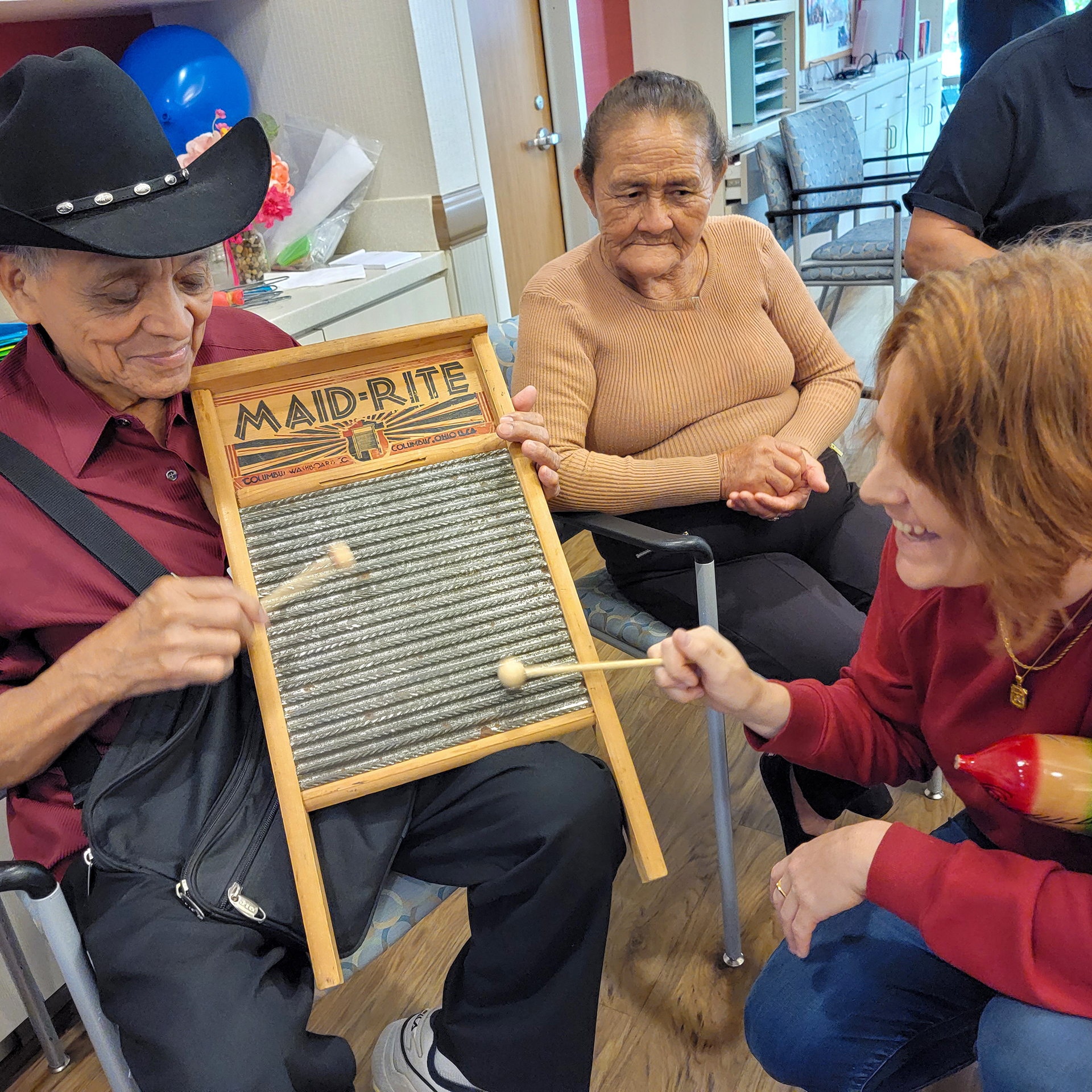
The Marvels of Music at Los Angeles Jewish Health
Around the world, December is a time for gift-giving, family meals, and shared celebration. It is also a time for music: from Chanukah medleys to Christmas classics, holiday tunes are the soundtrack of the season.At Los Angeles Jewish Health, music plays an integral part of uplifting seniors’ spirits and enhancing their health and wellness throughout the year, from birthdays to holidays and beyond. Well-documented evidence shows that music has numerous health benefits for people of all ages, perhaps none more so than members of an aging population.“Listening to music can help with anxiety, depression, and stress; it can also help reduce blood pressure and improve sleep,” says Noah Marco, MD, LAJH’s chief medical officer. “In addition, it activates parts of the brain that are involved in thinking, movement, and emotion. It’s been shown to help people recovering from a stroke with verbal memory and focus, and to connect people suffering from advanced dementia to their positive past memories.”Supporting seniors through music is a major focus of life at LAJH. The Music Therapy Program at the Brandman Centers for Senior Care PACE is just one example. A board-certified music therapist brings instruments to the center and involves participants in expressing themselves musically: singing and making rhythms while reflecting on how music has shaped their lives.Board-Certified Music Therapist Sara brings instruments to Brandman Centers for Senior Care PACE in Reseda“The program is awesome—the music is just wonderful. It helps you relax, stay calm, and it helps you mentally because by singing together with people in a group, you know you’re not alone,” says program participant Theresa Vincent. “I would encourage everybody to do music therapy at Brandman!”Music therapy is also provided to residents through a partnership with California State University, Northridge (CSUN). The collaboration brings students working toward their music therapy degree to LAJH, where they engage residents with percussion-based instruments and population-appropriate activities.The CSUN students’ effort and skill are deeply appreciated by those who take part in the gatherings. “These students bring so much joy and make us feel better, we forget about our troubles and are just happy,” says one memory care resident at LAJH’s Goldenberg-Ziman Special Care Center.Goldenberg-Ziman Special Care Center residents enjoy instruments provided by CSUN studentsAt the Joyce Eisenberg-Keefer Medical Center, residents participate in a different type of music therapy: the Wahlbangers Drum Circle, which leads them through low-impact exercises proven to activate both hemispheres of the brain.“From helping residents modulate their emotions to encouraging concentration and cooperation, the benefits of the drum circle are many-fold,” says Susan Leitch, director of therapeutic activities. “The activity is universally accessible: Everyone can play, no matter their experience level.”Wahlbangers Drum Circle leads musical participation at Joyce Eisenberg-Keefer Medical CenterYoung people frequently share their musical gifts with LAJH residents. “We are extremely fortunate to have so many talented individual musicians and groups volunteer from colleges, secondary schools, and synagogues. They visit LAJH almost weekly,” says LAJH Special Projects Coordinator Julie Lockman-Gold, whose role is supported in part by the Steven Ohren Foundation. In one instance, a resident had not played his bass in years, due to a stroke that made it challenging for him. A caring visit by a music major in college enabled him to feel confident in picking up his bass, and they played tunes together throughout the afternoon. Resident Andy jams on his bass guitar with a volunteer music majorThe number of outstanding performances is too numerous to list. Shining examples include a college student who has been playing the cello for LAJH audiences since he was in high school and a jazz band that performs for LAJH’s annual “Senior-Senior Prom.” Schools that have visited the campuses include UCLA, de Toledo High School, Brentwood School, Harvard-Westlake, Sierra Canyon School, Kadima Conservatory, and more. Jazz musicians from de Toledo High School play for the annual Senior-Senior dance at Eisenberg VillageIn honor of Father’s Day and thanks to support from the Steven Ohren Foundation, the Inner City Youth Orchestra of Los Angeles, the largest majority African American orchestra in America, treated residents to a moving concert. “I always tell residents, ‘You don’t have to go to Disney Hall to hear a phenomenal concert,’” says Stacy Orbach, Los Angeles Jewish Health’s director of volunteer services, “because we bring the sounds of Walt Disney Concert Hall to you!”The Inner City Youth Orchestra of Los Angeles treated residents of the Joyce Eisenberg-Keefer Medical Center to a Father's Day concertMusic plays a central role in LAJH’s Jewish holiday celebrations, as well. At Passover and Yom Ha’atzmaut, Jewish music specialist Cindy Paley joins Chief Mission Officer Rabbi Karen Bender and Rabbi Ron Goldman in leading residents in song. Shabbat and other prayer services also prominently feature music. “Our residents love music, so we incorporate it into so much of what we do here,” says Rabbi Bender. “Especially when we play Israeli or Yiddish songs, people respond so positively because that music really brings back memories.”Cindy Paley leads Grancell Village in celebrationThe music agenda at Fountainview at Eisenberg Village is robust. Entertainment is available two Saturday evenings a month, including a summer concert series. Music is also a pivotal component of holidays at Fountainview: the Swing Dolls, a 1940s-style, Andrew Sisters tribute band, performed this past Veteran’s Day and July 4th, and during Chanukah residents will enjoy the musical stylings of a traditional klezmer band.The Swing Dolls bring classic tunes to Fountainview at Eisenberg VillageLAJH’s myriad of music programs and therapies are made possible by the support of generous benefactors including The Steven Ohren Foundation—dedicated to assisting the elderly with medical and living expenses, with a special emphasis on the Jewish population—and Mount Sinai Memorial Parks and Mortuaries, a longtime supporter of LAJH residents, which recently made a gift to help expand LAJH’s music programs. Individual donors are also essential for the ability of the music programs to thrive.Residents at LAJH find many opportunities to showcase their own musical talents, as well. Whether playing a piano inside one of the residential buildings, staging a Passover play or Purim spiel, or teaming up with fellow residents to write and compose songs, many talented residents participate in the world of music available to them.Residents of Joyce Eisenberg-Keefer Medical Center wrote and performed their own musical Purim spiel“Music truly infuses everything at LAJH,” says Annette Weinberg, LAJH’s campus lifestyle and enrichment director for Eisenberg Village. “Watching residents’ faces light up when the music starts is just the most amazing thing.”
Nov
6
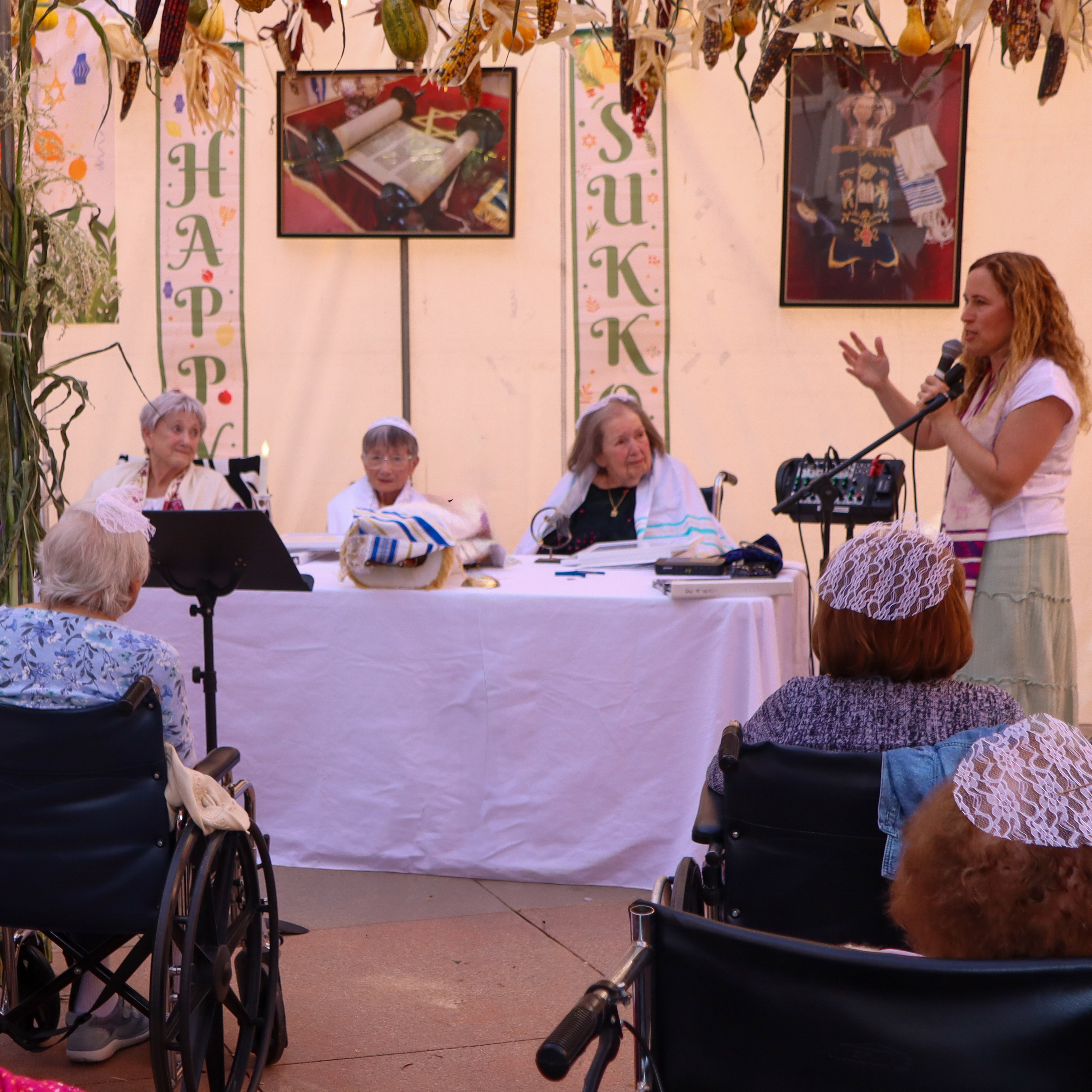
Confirmation and Inspiration at Los Angeles Jewish Health
The holiday of Sukkot—a Hebrew word meaning “booths” or “huts”—follows closely after Yom Kippur and is a joyous celebration of the autumn harvest. This year at Los Angeles Jewish Health, the holiday also marked another very special and happy occasion: the adult confirmation of three residents in their 80s and 90s who displayed their mastery of Jewish scholarship and prayer in front of a rapt audience of family and friends.Confirmation is a way for Jewish students of post-bar or bat mitzvah age to continue engaging with their tradition and confirm their commitment to Jewish life. Inside a gorgeous sukkah erected in the main courtyard of LAJH’s Grancell Village campus, the assembled guests listened to the women—Etta Spiegel, 96; Barbara Fallick, 82; and Linda Zweig, 81—all of whom had previously had adult bat mitzvahs, chant from the Torah and offer astute insights into Jewish history, ritual, and culture. The ceremony was held as a highlight of LAJH’s Friday afternoon Shabbat service, led by Chief Mission Officer Rabbi Karen Bender.“These women wanted to deepen their Jewish knowledge, and they studied with me for about a year in preparation for this day, ultimately becoming experts in an area of specific interest to them,” Rabbi Bender shared during the moving ceremony. “Their passion and determination are incredible to behold, and I am beyond excited for them to share what they’ve learned with you today.”Etta focused on the Passover story, making connections between the Pharoah of ancient Egypt and modern-day tyrants. Linda spoke about Midrash, a genre of Jewish commentary, and discussed the ways in which, when it comes to biblical interpretation, women (whose perspectives were once marginalized) are now empowered to be part of the conversation. Barbara delved into family dynamics in the Book of Genesis, with particular emphasis on the life of Jacob.At the conclusion of the service, Ilana Springer, CEO/administrator of the Joyce Eisenberg- Keefer Medical Center, presented each of the confirmands with a framed photograph of them with the Torah and complimented their dedication and drive. “Through their words and actions, these women demonstrate their faith, courage, and hope for the future of the Jewish people,” Springer said.LA Jewish Health Board Chair Judy Friedman-Rudzki gifted each of the women a sculpture, bearing their names and depicting a woman holding the Torah. “Your example shows us that there’s no limit to what we as women can accomplish!” she said.Also on hand was Dale Surowitz, LAJH’s president and chief executive officer, who congratulated the three residents on their tremendous effort and handed them each a certificate of adult confirmation to mark the occasion.“Thank you for showing all of us that age is only a number,” he said. “What you accomplished here makes clear that we can do anything if we put in the hard work and follow our hearts.”As she ended the service, Rabbi Bender offered Etta, Barbara, and Linda a special blessing and some heartfelt words of praise. “I have so much gratitude and respect for each of you,” she said. “You’ve truly inspired us all.”
Nov
6
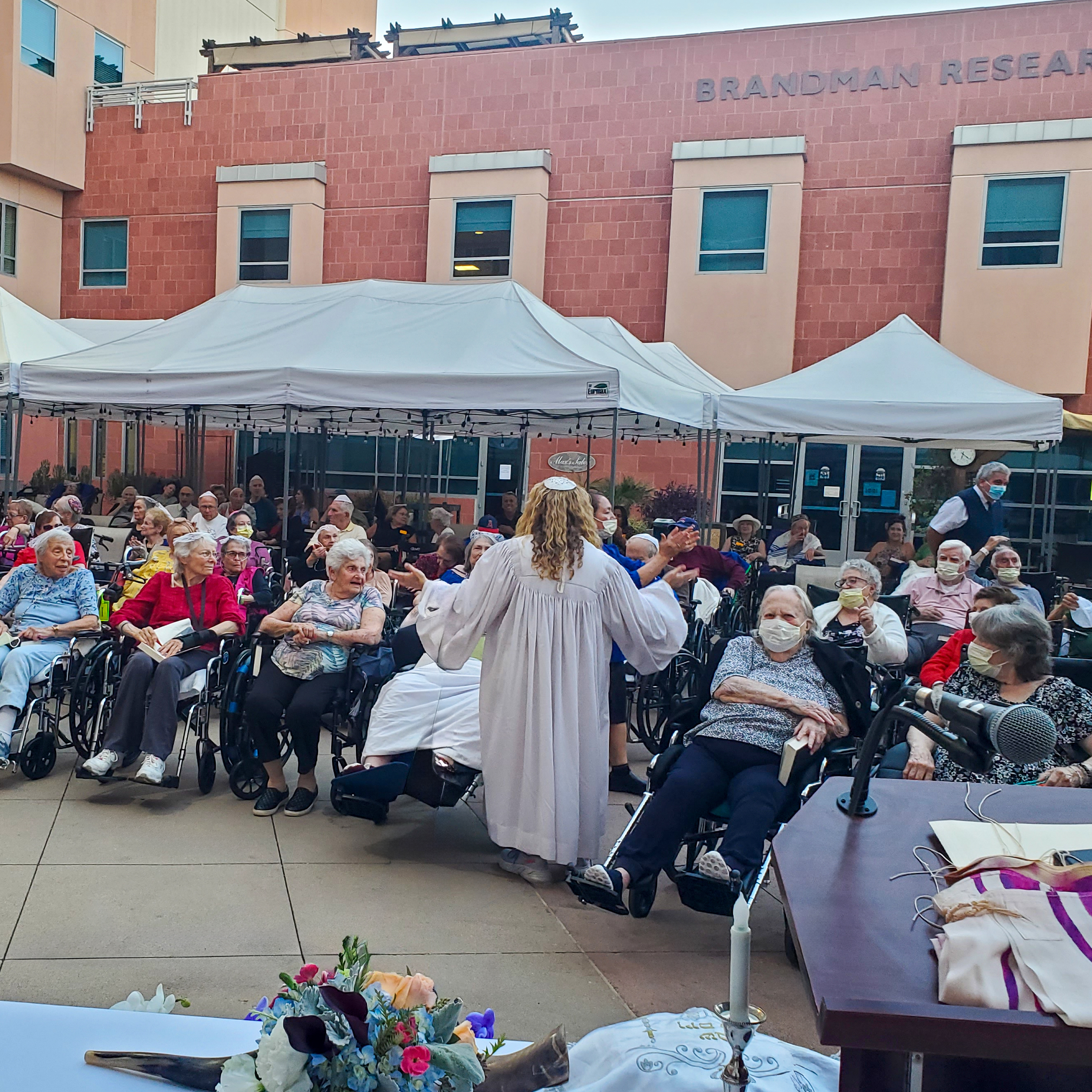
A Sweet Start to a New Year at Los Angeles Jewish Health
Every year, Rosh Hashanah and Yom Kippur—the holiest days on the Jewish calendar—present Los Angeles Jewish Health residents with multiple opportunities for both celebration and reflection. This year’s holiday events were as wonderful as ever, marked by beautiful music, meaningful prayer, and cherished traditions.Led by Chief Mission Officer Rabbi Karen Bender, as well as Rabbi Ron Goldberg, the spiritual leader for the Eisenberg Village campus, LA Jewish Health’s holiday observances offered something for everyone of the Jewish faith. There were multiple religious services held across both residential campuses. In the main courtyard at Grancell Village, Rabbi Bender—assisted by her son, Holden—was joined by cantorial soloist Benzy Kogen. Services at the Goldenberg Ziman Special Care Center, officiated by Rabbi Ron, included cantorial soloist Joel Stern. At Fountainview at Eisenberg Village, Rabbi Bender and cantorial soloist Aria Gittelson led residents in the holiday liturgy.The Fountainview service had some particularly special and unexpected moments. Professional musician David Clymer, the grandson of resident Audrey Stein, was on hand to blow the shofar. He filled the room with gorgeous, powerful shofar blasts, uplifting the assembled residents. Unfortunately, Audrey was not among those gathered; she was under the weather and resting in her room. Determined to ensure his grandmother was able to hear the shofar during this season of High Holy Days, David, accompanied Rabbi Bender and Aria Gittelson, stood outside Audrey’s room and serenaded her while she stepped outside in the fresh air and lovingly listened from her balcony above.David Clymer, grandson of resident Audrey Stein blows the shofar as she looks on from the balcony“David was a trumpet player from the time he was little; I think that’s why he’s such a good shofar player,” says Audrey, who was delighted by her private concert. “Hearing him together with Rabbi Bender and Aria was so touching; I was crying the whole time.”For his part, David—a freelance musician who performs throughout West Los Angeles in addition to arranging and composing music—felt honored to perform for his grandmother and to participate in High Holy Day celebrations at LA Jewish Health.“My grandmother is such an amazing person. The amount of love she has for people and for travel has meant a lot for me in my life and has taught me to be a good person. It was a joy connecting with her at LA Jewish Health in this way,” he said.Another signature feature of the High Holy Days at LA Jewish Health this year: eating apples and honey to symbolize hopes for a sweet year ahead. Gathered around holiday tables, residents were able to dip apple slices in several different varieties of honey as they visited with peers and engaged in Jewish learning.Thanks to the ingenuity of Rabbi Bender, residents were also able to participate in the tradition of tashlich (“casting off”). Typically taking place on the afternoon of Rosh Hashanah, the tradition is one in which people symbolically cast away their sins by tossing bread crumbs into a flowing body of water. While LA Jewish Health residents could not all travel to the Pacific Ocean to perform the ceremony themselves, they carried out a modified exercise utilizing the crumbs and bowls of water. Then, Rabbi Bender collected bread crumbs from them and drove to the beach herself, casting the crumbs into the water on their behalf, in the last afternoon sun.“At LA Jewish Health, every resident matters, and we will stop at nothing to bring them the joy of the holidays and the joys of life,” Rabbi Bender says.
Oct
2
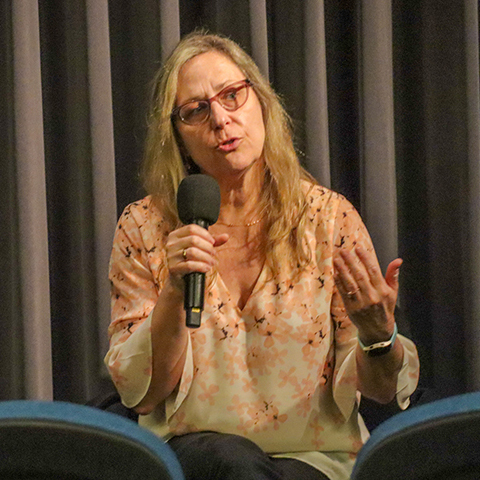
Seniors and the Benefits of Social Connections
Los Angeles Jewish Health is dedicated to ensuring the wellbeing of thousands of seniors each year. Physical health is just one indicator of how older adults are faring; mental and social health are also critical markers. This was the focus of a recent event held at LAJH’s Fountainview at Eisenberg Village featuring noted scholar Lené Levy-Storms, PhD.An associate professor of social welfare and medicine/geriatrics at UCLA, Dr. Levy-Storms addressed a near capacity crowd in the Fountainview Theatre about the importance of nurturing and maintaining social connections. It’s a topic that is drawing more attention as researchers deepen their understanding of the ways in which social health impacts human lives.“It’s programmed in our DNA to be social,” Dr. Levy-Storms said. “In fact, scientific literature shows that not having adequate social connections can yield the same adverse health effects as obesity and smoking.”Dr. Levy-Storms addresses the crowd at the Fountainview TheatreThis year, the U.S. Surgeon General released a report detailing what he called the country’s current “epidemic of loneliness.” According to the report, too many Americans feel an acute sense of social isolation. Dr. Levy-Storms noted that shining a light on the problem is essential to fixing it, since lack of awareness has prevented the development of vital resources.“We don’t have a healthcare system designed to give us remedies when we’re ailing from social health issues,” she said. “Beyond the healthcare arena, there’s also a big emphasis in our society on building up financial capital, and especially saving for retirement and older age. But where’s our social capital? What’s going to sustain us to feel connected as we get older and start to lose some of the people in our lives?”Dr. Levy-Storms’ talk was part of LAJH’s larger efforts around assessing urgent community needs. “Part of being a licensed nonprofit hospital means continually gauging how best to serve the people who rely on our care,” says Ilana Springer, the CEO and administrator of LAJH’s Joyce Eisenberg Keefer Medical Center. “Our most recent assessment revealed that seniors are particularly susceptible to isolation and loneliness, with 20%-40% reporting feeling lonely at any given point in time.”The solution, in Dr. Levy-Storms’ view, is not just building new relationships throughout our lives—it’s also making sure they are meaningful ones.“What is a meaningful relationship? The key is to establish emotional connections,” she said. “This requires us to get into a mindset of finding common ground with other people. It’s easy to say, ‘I don’t have anything in common with this person,’ but we can change that through listening and connecting with them. Then, hopefully, we experience reciprocity, where the listening goes both ways.”At the conclusion of Dr. Levy-Storm’s talk, the audience moved outside to chat over brownies and lemonade, giving them a chance to forge new connections and put her advice into practice.
Sep
4
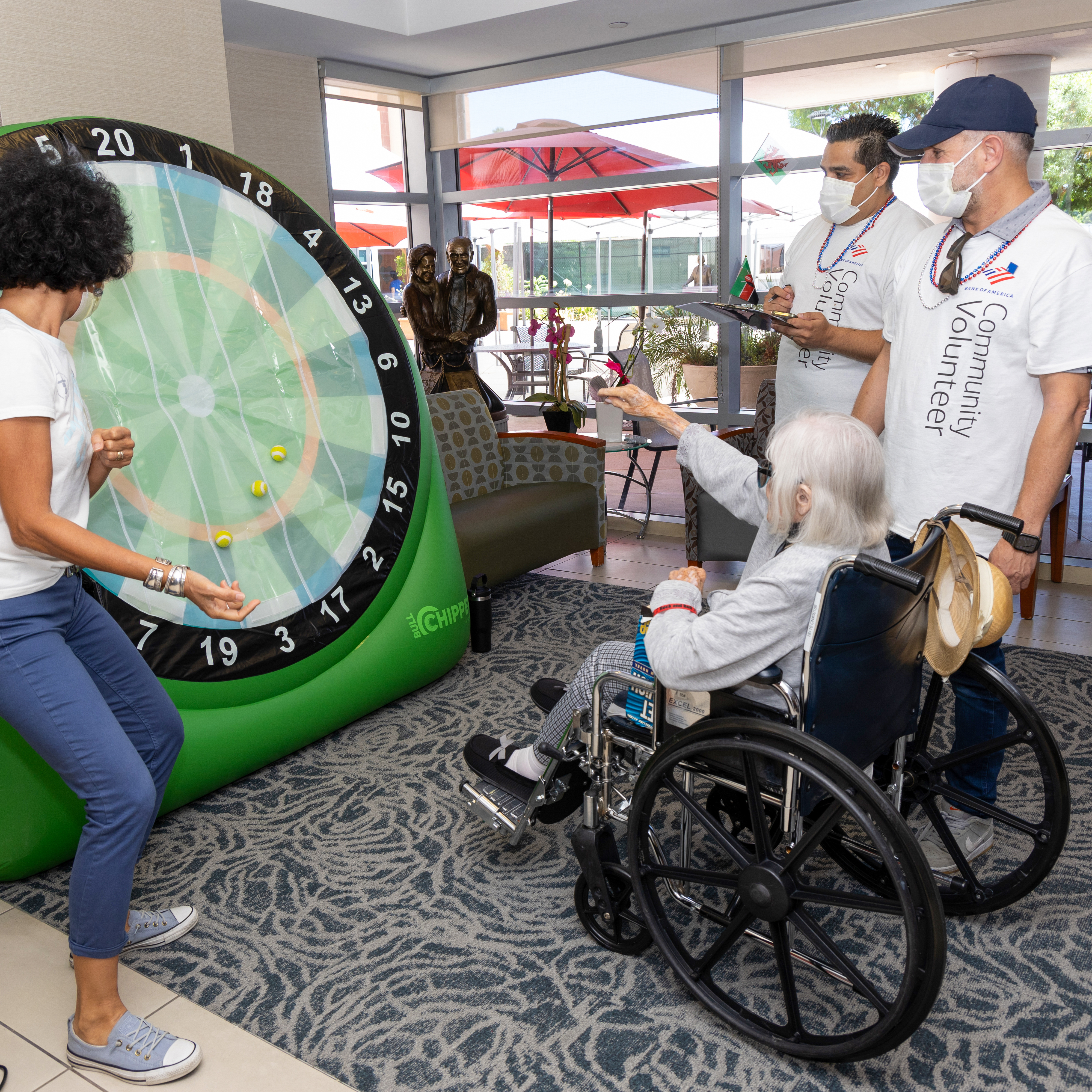
The Olympic Spirit Soared at Los Angeles Jewish Health Thanks to Winning Support from Bank of America
During a summer filled with exciting coverage of the 2024 Olympics in Paris, there was another, event right here in Los Angeles that brought talented athletes out to shine. This August, Los Angeles Jewish Health hosted its own Senior Olympics, engaging dozens of residents of the Joyce Eisenberg-Keefer Medical Center in an afternoon of fun and stimulating activities, enabling them to join in the celebratory spirit inspired by the Paris games.Critical to the success of the Senior Olympics was the outstanding participation of nearly 20 staff members from Bank of America, including Larry Schnaid, past president of Los Angeles Jewish Health’s support group, The Guardians. Led by Judy Friedman-Rudzki, director and senior treasury officer at Bank of America and LAJH’s current board chair, the energetic group were active participants as part of the bank’s long-time dedication to volunteerism and civic engagement. Bank of America encourages its more than 200,000 employees to be active in their local communities, to support the organizations that revitalize their communities. Collectively, bank employees log millions of volunteer hours each year.“Bank of America believes its employees should give back because we are part of the tapestry of the community,” notes Judy Friedman-Rudzki, director and senior treasury officer at the bank and LAJH’s new board chair. “I am thrilled that, through events like the Senior Olympics, I can help bring two fantastic organizations—LAJH and Bank of America— together to make a critical difference for seniors in Los Angeles and beyond.”These types of collaborations help LAJH improve the health and well-being of thousands of seniors each year. “Judy and her dedicated colleagues at Bank of America are wonderful partners with us,” says Dale Surowitz, LAJH’s president and chief executive officer. “The generosity of groups like theirs helps extend our reach into the community and bolsters our impact as a key health resource for so many seniors citywide.”The Senior Olympics event was classic LAJH—finding creative ways to engage and challenge seniors as they enjoyed the company of fellow residents, staff and especially the new friendships made with the outstanding Bank of America volunteers. LAJH’s staff lead for planning and orchestrating the event was Susan Leitch, director of therapeutic activities. “Programs like this promote socialization, friendly competition, and feelings of self-worth and satisfaction among our residents. They also instill a sense of camaraderie between residents and their peers,” she says. “This Senior Olympics event was fantastically successful: The day after, residents kept asking when we’d be having the next one. We have already started to plan a version of the games for next year!” Participating residents had six games to test their skills: Tic-Tac-Toe, Giant Dartboard (using cloth balls instead of darts), Basketball, Badminton, Cornhole, and Bowl Chipper, a variation on golf. All games were held indoors, keeping residents nice and cool from the late summer San Fernando Valley heat. The lobby and multipurpose room were decorated in the spirit of the Olympics, including flags from around the world and banners hanging from the ceiling, lending the space an international air.Participants included 101-year-old LAJH resident Sadie Migden and Suzanne Blum, an 86-year-old resident who stopped by to check out the event, which she says was indicative of the level of care LAJH puts into everything it does. “LAJH does so many things well,” she says. “This is the best place in the city for skilled nursing care; you can rest assured that if you need help with something, you can find that help here.”Click here for a full gallery of images from the Resident Olympics with Bank of AmericaFor More Images from the Resident Olympics with Bank of America Click Here
Sep
4
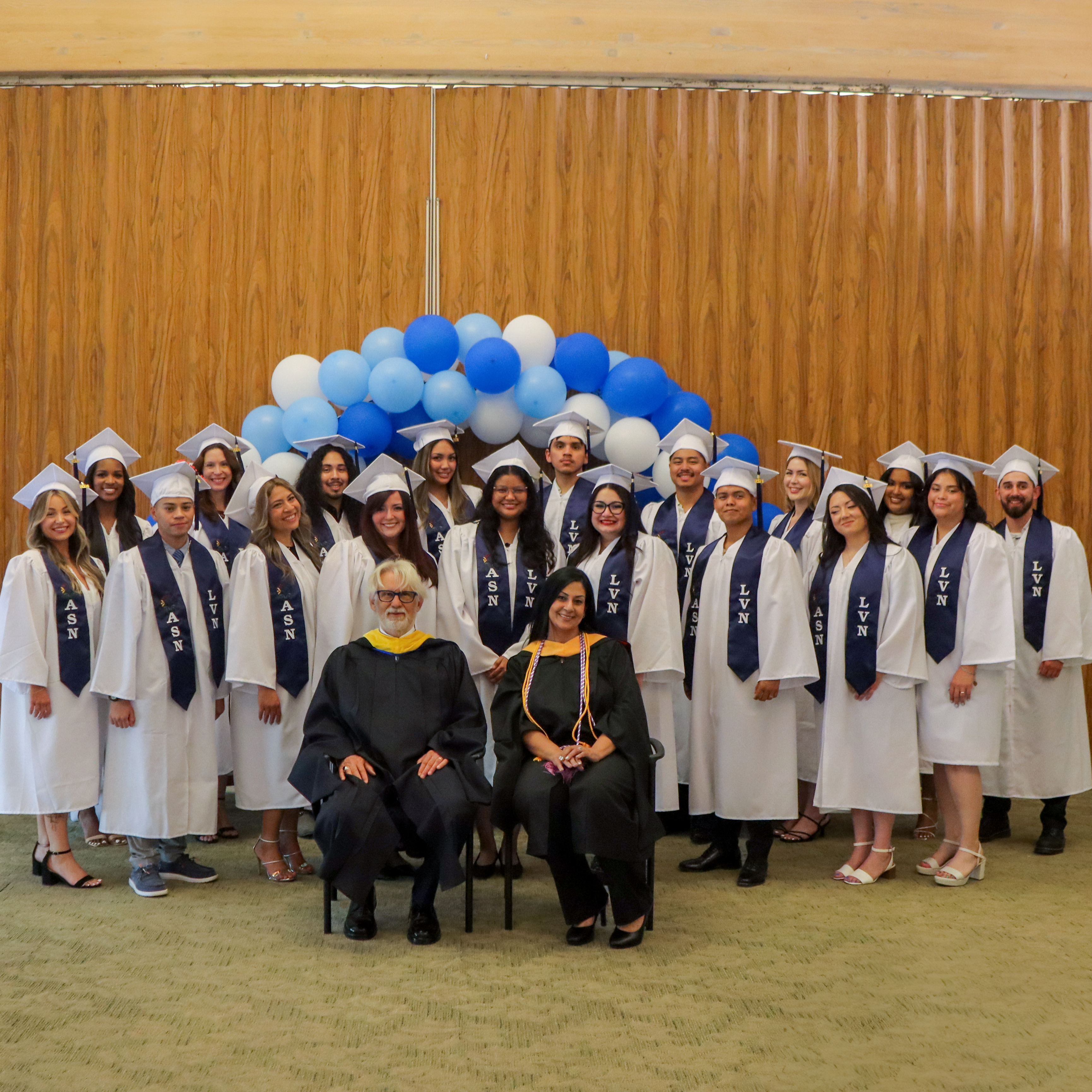
Annenberg School of Nursing Graduates Future Leaders in Healthcare
The nursing profession in California is in dire need of reinforcements: Estimates show a statewide shortage of nurses made worse by burnout from the COVID-19 pandemic. In August, Los Angeles Jewish Health (LAJH) continued doing its part to increase the numbers of talented nurses by graduating a new class from its highly regarded Annenberg School of Nursing (ASN).The 18 graduates join a long list of distinguished alumni making a critical difference in the well-being of seniors at LAJH, as well as many other health agencies, hospitals, and care settings across Los Angeles and beyond.“This year’s class should be incredibly proud of their achievements, not only because they worked hard and distinguished themselves, but also because they are now equipped to go out into the world and help strengthen their local communities,” says Amandeep Kaur, director of the nursing school.It was standing room only for the crowd of more than 400 attendees, who joined the graduates for a moving and meaningful ceremony at LAJH’s Pepp Center Dining Room, located on the Eisenberg Village campus. Executive leadership from LAJH participated in the event, among them Chief Human Resources Officer Alyssa Alderman, who served as master of ceremonies; Rabbi Karen Bender, chief mission officer; Rabbi Ron Goldberg, Eisenberg Village rabbi; and Sheldon Steier, president of the ASN Board of Directors.The graduates represent the best and brightest of a new generation of nurses. Entry into the school is competitive: Out of more than 100 applicants, only 24 make the cut for admission to each class. Many of those individuals—including 16 of this year’s 18 graduates—are the first in their families to have earned a college degree.Student speakers played a prominent role in the ceremony. Class valedictorian Kierra Westbrooks spoke movingly about what motivated her to pursue a career in nursing and enroll at ASN.“During the COVID-19 pandemic, I watched the overwhelming need for nurses and felt helpless sitting at home,” she recalled. “That was the moment I knew I wanted a career where I could make a difference, ensuring I would never be deemed ‘non-essential’ again.”Jake Racimo, vice president of the Class of 2024, offered appreciation on behalf of his fellow graduates for the support they received during their ASN journeys.“I want to extend my thanks to LAJH and the Annenberg Foundation for the generous donations you have given to this program, not only to assist the students financially, but also to make our dreams into a reality,” he said. “And to the board of directors at LAJH and ASN and to [LAJH President and CEO] Dale Surowitz, thank you for navigating us toward a successful nursing career.”Class president Ashley Davis, who received the coveted Florence Nightingale Award, congratulated her peers on reaching such an important milestone.“We finally made it to the finish line,” she said. “I can’t wait to see what life has in store for us.” ASN Graduation Gallery Click Here For More Graduation Pictures Click Here
Aug
7
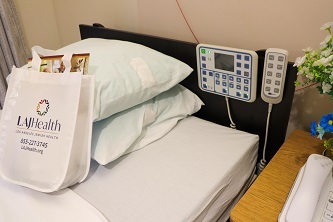
Los Angeles Jewish Health Launches New Program Treating Seniors with Congestive Heart Failure
Los Angeles Jewish Health (LAJH), a leader in senior care, has launched a dedicated unit equipped to treat seniors suffering from congestive heart failure (CHF)—a condition where the heart is unable to pump blood well enough to the body.The new unit enables patients with CHF to shorten hospital stays by spending a period of time in short-term rehab at LAJH prior to returning home. It also reduces readmissions back to the hospital compared to discharge straight to home.“Nursing facilities don’t usually have deep expertise in acute congestive heart failure, so we’re definitely leading the way here,” says Noah Marco, MD, chief medical officer of Los Angeles Jewish Health. “Working with a multidisciplinary team of doctors, pharmacists, nurses, and administrators, we have developed a new standard of care, educated our staff, and formed partnerships with local hospitals, letting them know we are an important source of support in this area.”The program features six specialized beds funded by the Office of the Third District of L.A. County’s Board of Supervisors. An additional 26 beds will arrive this fall, thanks in part to generous support from the Ahmanson Foundation. The high-tech beds monitor patients’ body weight, and, along with labs, EKGs, and lung fluid measurements, help inform the most effective course of treatment.“In addition to the clinical team, our social services team helps provide patients with the resources to be successful following their stay with us,” says Charlette Ofrecio, administrator of the Mark Taper Building. “We teach about heart-healthy diets and how to monitor lung fluids at home, demonstrate strengthening exercises, and show patients how to incorporate regular activities into daily routines.”“Prior to discharge, a pharmacist meets with patients to review their medications, and our registered dietician provides dietary recommendations to help manage their conditions at home. We also conduct a post-discharge follow up, ensuring they have a good understanding of what they need to do for their ongoing care,” says Sandy Carrillo, the Mark Taper Building’s director of nursing. “We only graduate residents from the CHF program once they’re stable and showing no signs or symptoms of CHF.”Daniel Manavi, MD, a non-invasive cardiologist at Providence Cedars-Sinai Tarzana Medical Center and director of congestive heart failure at LAJH, says the establishment of a program like this has been years in the making.“Throughout my practice, numerous facilities have entertained the idea of launching a CHF unit, but only Los Angeles Jewish Health recognized the need to invest in this program and actually found the resources to do so,” he says. “LAJH is doing a great job, and I am honored to be collaborating with the organization’s leadership to care for members of our local community.”Going forward, LAJH plans to add additional specialty services based on the CHF program model.“Our CHF Unit is just one of the steps we are taking toward offering personalized care to an aging senior population,” says Dale Surowitz, Los Angeles Jewish Health’s president and chief executive officer. “We look forward to developing innovative approaches that will keep seniors healthy and enhance the quality of their lives.”
Aug
7
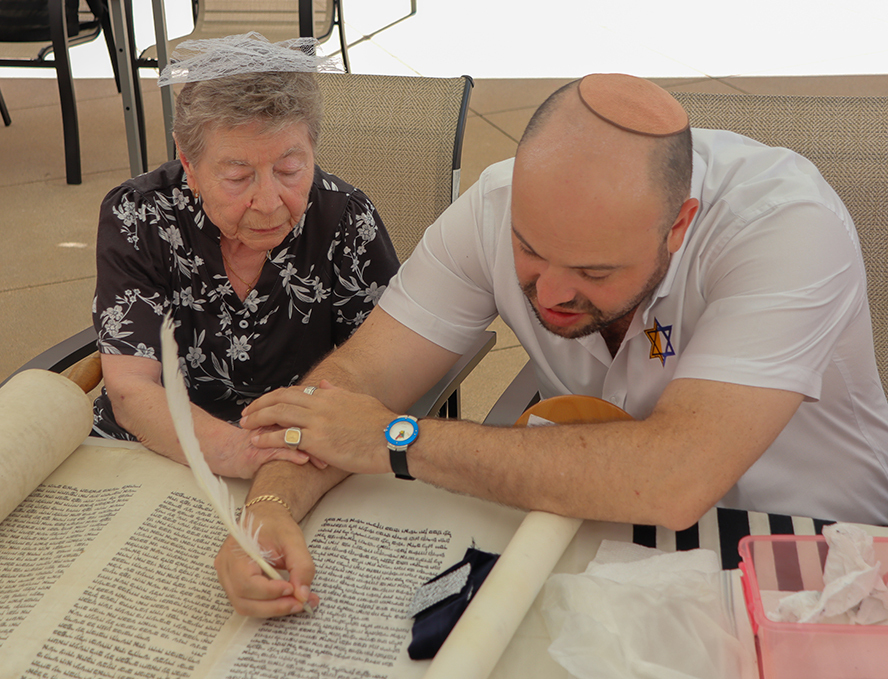
A Cherished Relic that Survived the Holocaust Comes to Los Angeles Jewish Health
A Cherished Relic that survived the Holocaust Comes to Los Angeles Jewish HealthIn addition to the thousands of older adults served by Los Angeles Jewish Health (LAJH) for more than a century, it has been a special honor to provide comfort and care to hundreds of Holocaust survivors who have called LAJH home. Some of these cherished residents have recounted their powerful stories over and over again, in discussion groups, public speaking engagements, recordings for the Shoah Foundation and the Library of Congress. Others, choose not to speak about this dark time in their family’s and the world’s history. Recently, an extraordinary event took place at LAJH when the thirty survivors in residence were given the opportunity to not only touch a sacred piece of history but to join in its rejuvenation, so that it can continue to educate others on the atrocities of the past so that they might never be repeated. This powerful message is brought to life through an ancient Torah scroll that has been severely damaged by time, neglect and war. Jonny Daniels, founder of an international nonprofit, From the Depths, travels the world seeking out survivors of the Holocaust to take part in this restoration project. With a mission of preserving the memory of the Holocaust and using its lessons to shape a better future, Daniels is a scribe specially trained in the art of writing holy texts onto parchment.This story began when a Torah scroll, the holiest book in Judaism, remained hidden for 70 years at a home in a remote Polish village until university students visiting for another project came upon it. While visiting with a local couple the students learned that long ago the family’s neighbors had been religious Jews. Before being deported during the war they had asked their non-Jewish neighbors to keep the Torah scroll safe until they returned from the camps. This is an example of the critical role so many righteous non-Jews played during this time in history. The Rabbi never returned. Over the years, the scroll’s condition greatly deteriorated. During the past 70 years, out of necessity, half of the Torah had been utilized by the family for items such as rags, and insoles for shoes. Now, the family decided to share the scroll with these students. They lifted cushions from a couch and revealed a brown-paper wrapped Torah scroll hidden there in 1939 when the Jewish population of approximately 280 was deported and murdered. Daniels describes his work this way, “We work extensively in Eastern Europe, where we seek to rediscover hidden Jewish heritage.” “When we located this Torah, which managed to withstand the ravages of Nazi aggression, we knew the most fitting way to honor it would be for Holocaust survivors to participate in rewriting it. We are dedicated to finding those survivors who are left and to having them help make the Torah whole again.”So, on a recent very special afternoon in the outdoor courtyard and synagogue of Los Angeles Jewish Health, the emotion was palpable, as survivors, who trace their origins to Poland, Russia, Germany and Hungary, gathered. Then, one by one, they were each given the honor of touching the Torah, then pulling it in closer to them. Each then placed their hands on Daniels’ arm as he carefully inked new letters on fresh parchment to replace the portion of the scroll that had been desecrated. He patiently spoke with each of them (many in their native languages of Russian, Yiddish and Hebrew), explaining that they were fulfilling a Jewish commandment to write the Torah. All who had gathered, the survivors and staff, were overflowing with emotion with many wiping tears from their eyes.Chief Mission Officer for Los Angeles Jewish Health Rabbi Karen Bender, was clearly moved by the gathering and spoke about the significance and honor of having the Torah make its way to LAJH, and the extraordinary resilience of the Jewish people and religion.“Like some of our LAJH residents, this Torah is a survivor of the Holocaust. Bearing witness to our survivors writing letters in a Torah scroll that is being revived, repaired, and completed in honor of them and by them was one of the most meaningful Jewish experiences of my life,” she said. “I felt that they were doing this in honor of the six million Jews who perished during the Holocaust, including and especially their own family members—and, frankly, including even my own family members who died.”In summing up the mission of From the Depths, Daniels describes, “The Torah is what binds us as a people, what connects us as Jews from one generation to the next. To find this Torah scroll, even in its current condition, was completely overwhelming. This is a clear symbol of triumph, showing again the victory of the Jewish spirit over those who try to exterminate us,” he said.After its repair is complete, Daniels intends to donate the scroll to the Knesset (Israeli House of Representatives) in a ceremony attended by politicians and Holocaust survivors from throughout the world.
Jul
2
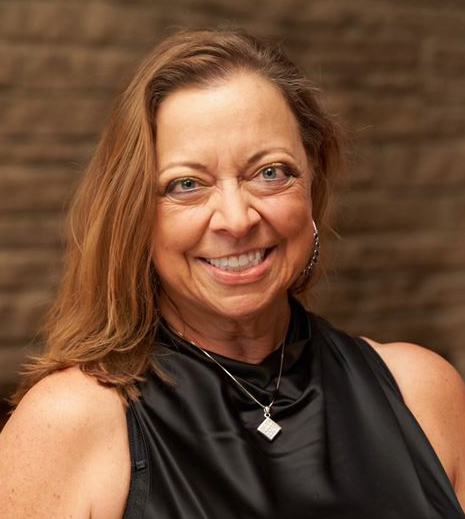
Judy Friedman-Rudzki Elected Board Chair of Los Angeles Jewish Health
One of Los Angeles Jewish Health’s most significant strengths is its lay leadership—women and men who give generously of their time and expertise by serving on the organization’s various boards. This July, we are extremely fortunate to welcome Judy Friedman-Rudzki as incoming Chair of LAJH’s Board of Directors. It’s the continuation of a long and fruitful collaboration during which Judy has worked tirelessly to make life better for seniors across our community.LAJH first came onto Judy’s radar in 2007, when her beloved great aunt, who was grappling with early onset dementia, moved from her own apartment in L.A.’s Fairfax District to LAJH’s Grancell Village campus.“The care and support were absolutely incredible. As my aunt’s dementia progressed and her needs changed, LAJH was right by her side, ensuring she received the very best of everything,” Judy recalls. “I was impressed and decided to get involved in helping the organization advance its mission, joining the board in 2009. I haven’t looked back since.”Over the past 15 years, Judy’s service to LAJH has been expansive. She has been an active participant on the board’s Strategic Planning Committee and chaired its Budget and Finance Committee and in-residence Boards for both the Grancell Village and Eisenberg Village campuses of LAJH. In addition, she has served on the Board of the Annenberg School of Nursing. Her new role as Chair of the Board of Directors—making her only the second woman at LAJH to occupy this position—will span a two-year term.“As CEO of LAJH, I am delighted to welcome Judy as our new Board Chair. Her deep commitment to our mission and her exemplary leadership qualities will undoubtedly continue to steer us towards even greater achievements in senior care and community health. Together, we look forward to continuing our legacy of compassionate service and innovative care for all those we are privileged to serve,” said Dale Surowitz, LAJH’s president and chief executive officer.In her professional life, Judy is a director and senior treasury officer at Bank of America, giving her a critical perspective on LAJH and how it seeks to achieve its objectives.“In my position at Bank of America, I work with companies, understanding their business model, their sources of revenue, and business processes. I bring that same lens to the nonprofit world. LAJH does rely on the community for support, but I think it’s also essential to take a look at what we can do to help support ourselves, just like any business. Being fiscally responsible is of paramount importance,” she says.As her term kicks off, Judy has set herself a number of key goals. “There are four main things on my radar as chair,” she notes. “First is supporting LAJH’s leadership. Dale has aligned a great team and vision; I see my job as supporting him to do his. I’m also excited to engage with the broader community, working with donors and enhancing LAJH’s visibility and impact. My third area of focus will be sharing the organization’s plan for growth—spreading the word, for instance, about how we plan to bolster care for seniors citywide through an expansion of our PACE facilities like the Brandman Centers for Senior Care. And finally, I’ll be concentrating on evaluation and continuous improvement. Regularly assessing how we’re doing is the fiduciary responsibility we have to our donors.”Settling into her role as chair will be made easier by the support she has from the leadership at Bank of America. “The bank encourages volunteerism and community engagement. I am grateful for their commitment to better the communities where we live and which we serve,” she says.Judy traces her commitment to working on behalf of the Jewish community to her upbringing as the child of a Holocaust survivor. Her dad fled Poland as a child, living in five different countries before making his way to Canada. When Judy was young, her family immigrated to the U.S. with $100 to their name, ultimately settling in Los Angeles.“I grew up with very little, but my parents modeled a life with Jewish values, and it’s made me so thankful for what I have—and dedicated to finding ways to pay that forward,” she says. “That’s what’s so special about LAJH: We involve the entire community in building a place our elders can rely on now and in the future. Knowing we’re establishing this legacy, from generation to generation, is powerful and is something that keeps me going every day.” Friedman-Rudzki and other guests at the Fall 2023 Reflections Gala